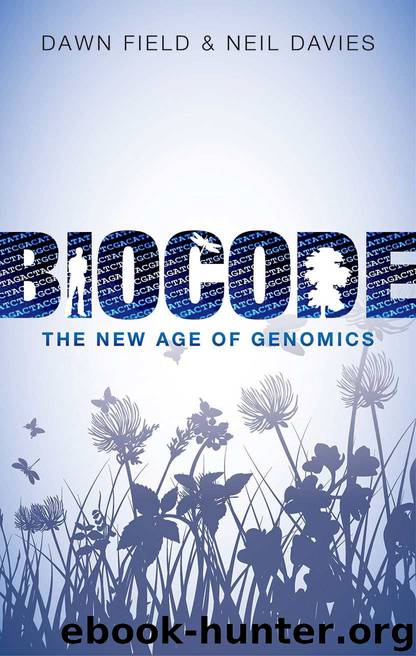Biocode: The New Age of Genomics by Dawn Field & Neil Davies

Author:Dawn Field & Neil Davies [Field, Dawn]
Language: eng
Format: azw3, epub
ISBN: 9780199687756
Publisher: Oxford University Press
Published: 2015-01-31T05:00:00+00:00
Shock and awe
We are blindly transforming a system on which our prosperity depends. These DNA stories show us that we are terra-genoming the Earth at an increasing pace, and we have a limited understanding of the implications of such changes. In fact, we are still stuck at the inventory stage—only just beginning to learn how much life there is on Earth.
So just how many species are there? Ecologist Lord Robert May drew fame for asking this question.191 To his dismay, he is still awaiting an answer. In a 2010 article he asked: ‘If some alien version of the Starship Enterprise visited Earth, what might be the visitors’ first question? I think it would be: “How many distinct life forms—species—does your planet have?” ’192 Embarrassingly, he reminds us, our best-guess answer would be in the range of 5 to 10 million eukaryotes, never mind the viruses and bacteria, but we could defend numbers exceeding 100 million, or as low as 3 million.
Most life has not yet been described. In 2011, Camilo Mora of Dalhousie University, Canada and colleagues produced an estimate of global diversity. They argued that the higher-level groupings of taxonomic classification followed ‘a consistent and predictable pattern from which the total number of species in a taxonomic group can be estimated’.193 From this they estimated almost 9 million eukaryotic species on Earth, of which some 2.2 million are marine species. Their numbers broke down as approximately ~7.77 million animals, ~298,000 plants, ~611,000 fungi, and ~36,400 protists.
This narrows the playing field but is still an underestimate. It doesn’t include the Bacteria or Archaea, the vast majority of genomic biodiversity. Mora’s study found that 86 per cent of the eukaryotic species on land and 91 per cent in the ocean still await description. They estimated that, based on a taxonomic ‘business as usual’ scenario, describing all these species might cost some US$364 billion, 100 times more than the Human Genome Project, and would require 303,000 taxonomists working for more than a millennium.
New species continue to turn up. Quentin Wheeler’s International Institute for the Exploration of Species (IIES), formerly at Arizona State University, selects the top 10 of them as the ‘shock and awe’ species of the year.194 Recent winners include a bat the size of a raspberry, a glow-in-the-dark cockroach, a yellow mushroom that looks so similar to the cartoon character SpongeBob SquarePants it is named Spongiforma squarepantsii, and a harp-shaped carnivorous sponge (see Figure 5).
The vast numbers of unknown species, or dark taxa, are just the tip of the iceberg. With them come unknown genes. ‘Unknown’ genes dominate most metagenomic studies of microbes, representing one of the great challenges of genomics.195 Some fall into known gene families, but a large number are ‘orphans’. Orphaned genes belong to small, rare, or poorly sampled gene families. Even the human genome still harbours genes that have no ascribed role. It was not just the small number of genes in the human genome that was shocking, but also the general number of orphaned and uncharacterized genes.
Download
Biocode: The New Age of Genomics by Dawn Field & Neil Davies.epub
This site does not store any files on its server. We only index and link to content provided by other sites. Please contact the content providers to delete copyright contents if any and email us, we'll remove relevant links or contents immediately.
Sapiens: A Brief History of Humankind by Yuval Noah Harari(14322)
The Tidewater Tales by John Barth(12627)
Mastermind: How to Think Like Sherlock Holmes by Maria Konnikova(7281)
Do No Harm Stories of Life, Death and Brain Surgery by Henry Marsh(6908)
The Thirst by Nesbo Jo(6882)
Why We Sleep: Unlocking the Power of Sleep and Dreams by Matthew Walker(6659)
Life 3.0: Being Human in the Age of Artificial Intelligence by Tegmark Max(5518)
Sapiens by Yuval Noah Harari(5325)
The Longevity Diet by Valter Longo(5044)
The Body: A Guide for Occupants by Bill Bryson(5032)
The Rules Do Not Apply by Ariel Levy(4912)
The Immortal Life of Henrietta Lacks by Rebecca Skloot(4552)
Animal Frequency by Melissa Alvarez(4430)
Why We Sleep by Matthew Walker(4395)
The Hacking of the American Mind by Robert H. Lustig(4342)
Yoga Anatomy by Kaminoff Leslie(4334)
All Creatures Great and Small by James Herriot(4273)
Double Down (Diary of a Wimpy Kid Book 11) by Jeff Kinney(4244)
Embedded Programming with Modern C++ Cookbook by Igor Viarheichyk(4143)
